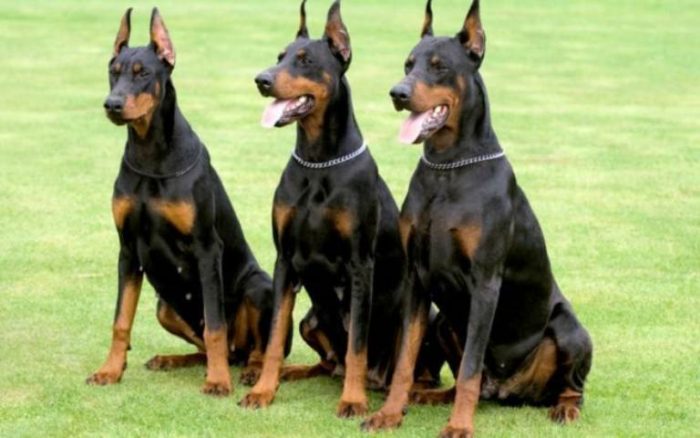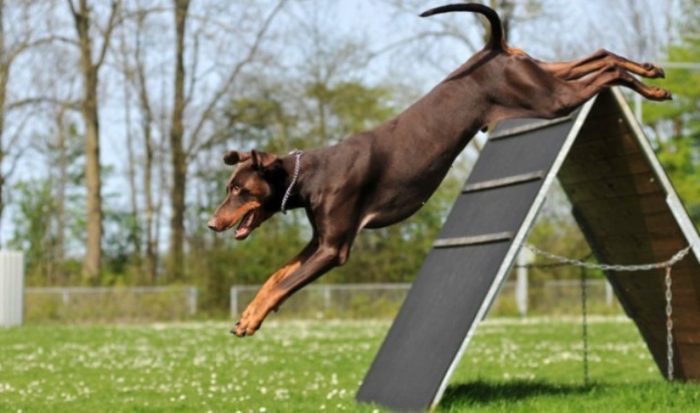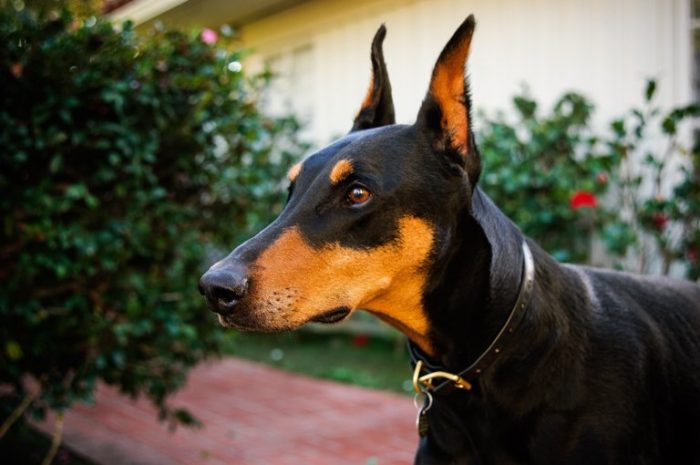The Doberman Pinscher pup is one breed that knows how to scare visitors who come unannounced. The Dobie is listed among the most dangerous dogs worldwide. Originally bred to have a ferocious appearance; the canine still retains that fierceness and on the list of the best guard dogs globally, Doberman puppies rank in the top ten. Despite their ferocious beginnings, Doberman puppies have several other traits deliberately bred into them that have made the capable canine an enduring companion in families that adopt them. For this write-up, we are focusing on the characteristic of the Dobie, including details about its training, grooming, and the likes.
Table of Contents
Origin of the Breed
The credit for the creation of the Dobie goes to Louis Dobermann – a German who developed the breed around the late 1800s. The man earned a living as a tax collector, which necessitated that he had company while making his rounds. Being the keeper of their local pup pound, he had access to a lot of strays and decided to have a go at creating a new fierce breed.
We cannot say for sure, but it is believed that the breeder crossed several sleek breeds before he arrived at the Doberman pinscher. The breeds that were said to be involved are German Pinscher, Rottweiler, German Shepherd, Great Dane, English Greyhound Shorthaired Shepherd, and Manchester Terrier.
Though the breed was developed and still functions as guard dogs worldwide, the Dobie has also been used as military and police dogs, therapy dogs, as well as rescue dogs.
Breed Characteristics of the Doberman Pinscher
We are going to group the characteristics of the Dobie into physical attributes, temperament, and health.
Physical Attributes
1. The short flat coat of the Doberman can be obtained as black and blue with rust markings, or brown and fawn with tan markings. The dog’s secondary color markings can be seen on its muzzle, above the eyes, limbs, chest, below the tail, and feet. The coat is equally thick, shiny, and smooth, lying very close to the dog’s body. Shedding is minimal, and maintenance is easy. The head is sleek and long with a muscular body.
2. The size of the Dobie is medium to large with a bodyweight of about 32 kg for the male that stands between 27 to 28 inches in height and 27 to 29 kg for the females that come two inches shorter than their male counterparts.
3. The breed is blessed with remarkable endurance, squarely built, strong, agile, and very fast.
4. Other physical attributes of the Doberman puppies include a long tail and floppy ears, but there is this practice of cropping their ears and docking their tails that still exist today. The essence is to stop the long tail from getting into the dog’s way as it performs its duties. As for the ears, cropping them will make the dog more alert as its hearing becomes sharper while on guard. Important to note that some countries have passed laws to make the practice illegal.
5. Life expectancy for the Dobie is between 10 to 12 years.
Temperament

The affectionate and sweet nature of the Doberman Pinschers makes them great as people-oriented pups. Though the ferocious appearance may initially scare you, early socialization and training mellow the dog’s temperament, giving it that friendly disposition. If raised alongside children, the Dobie can be a great companion for them. The canine is known to show unconditional loyalty to its family; however, there are a few members of the breed that bond to one person.
This power-packed canine is bursting with energy, thus plenty of exercise is needed. Neglecting their exercise needs means that they will turn aggressive and irritable. So if you don’t have quality time to spare for your pet dog, the Dobie is not the ideal pup for you.
Health
Generally, the Doberman Pinscher is a healthy breed but is still susceptible to certain health issues. They include:
Von Willebrand’s Disease
This is a condition in which the blood clotting mechanism is impaired; it causes excess bleeding after surgery, gum bleeding, nose bleeding, and internal bleeding in the intestines and stomach.
Hip Dysplasia
This is a congenital condition where the thighbone and the hip bone don’t fit together. The ailment can develop into arthritis with time, and it is not advisable to breed pups with hip dysplasia.
Progressive Retinal Atrophy (PRA)
With this condition, the dog’s retina will undergo a gradual deterioration, causing night blindness for the affected dog. Since the dog performs well as a guard, having an impaired vision is a huge problem.
Hypothyroidism
This is a thyroid gland disorder that plagues Doberman puppies. The effect of this health challenge leads to hair loss, epilepsy, lethargy, obesity, and skin disorders.
Wobbler’s Syndrome
The compression of the spinal cord is evident with this condition, and the cause may be a spinal canal that is malformed or instability in the cervical vertebra.
Cardiomyopathy
This occurs when the dog’s heart muscles become weak and thin. In this case, the heart chamber dilates, leading to an abnormally enlarged heart.
Other health issues that may ail your Dobie include albinism, color mutant alopecia, narcolepsy, gastric dilatation-volvulus, or bloat.
How to Take Care of Doberman Puppies and Adults
From the importance of exercise, nutrition, and grooming, below are ways to take care of Doberman puppies.
Feeding
High-quality food is compulsory for your Doberman Puppies, but you must share it in portions and regulate the number of times you feed the dog. Some adopters feed two portions, one in the morning and another in the evening; this is preferred over free feeding. However, since the dog is prone to bloat, you must try to guard against it by feeding a smaller portion several times daily. Again, water should only be made available when the dog has rested after eating, and if the pooch just underwent a heavy exercise session, withhold the food for the next hour.
Grooming
Dogs that are short-coated have very low grooming requirements, and your Dobie is one of them. Once a week brushing is just right to eliminate dead hair. Baths can come when the need arises, like once every two months. Dental care should be taken seriously to prevent periodontal diseases, once a day or once a week will suffice. The ears and eyes equally need care, and the claws should be clipped as at when due.
Exercise

For the breed to thrive, mental and physical exercises are compulsory. All that pent-up energy must be exerted; the same is true for the dog’s inherent sharpness that needs an outlet. The dog can easily turn uneasy and destructive if its exercise needs are neglected. Daily walks will suffice; however, the canine can accompany you on your jogging, running, and cycling sessions. Mental stimulation for the pup can include hide and seek using toys, and you can also make out time to play with your Dobie.
Read Also; High-Calorie Dog Food: How To Make My Dog Gain Weight
How to Train Doberman Puppies
Training for the Doberman breed is a pleasure as the dog is so smart, intelligent, willing to imbibe new skills, and eager to please. The pup learns and never forgets, and even with all their outward toughness, the canine breed is quite sensitive; thus, avoid loud shouting and scolding when you notice a mistake. Once the dog sees you as its pack leader, a firm voice will achieve positive results.
Naturally, the Doberman puppies are bred as watchdogs and guard dogs, so the barking may go a bit overboard. If this is the case with your pooch, then you must train it to recognize when to stop. Since the dog belongs to the large, strong, bright canine category, obedience training is important. You can leverage any obedience school in your locality to achieve this. The breed can excel in canine fields, and so, they enjoy agility training, flyball, search-and-rescue, and therapy dog training. Housetraining for the Dobie is quite easy and can be achieved in no time at all.
